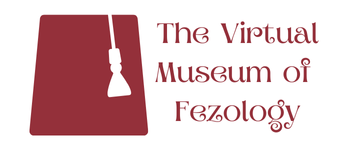Fezzes of Unknown Origin
If you have an idea on where any of these fezzes may have originated, please stop by the contact page and let us know!

This piece is only a half mystery. Purchased at auction, this is the second fez in the collection that has been sewn to make it shorter (the other being the Chinar Grottoettes piece.) We do know that this piece belonged to some sort of Shrine related group, thanks to the emblem on the front (which is actually a small pin.) We believe this fez belonged to a ladies group for few reasons; first, the fez is small, making it perfect for a lady’s head. Second, women tend to favor white fezzes. Lastly, the tassel is on the right, whereas men’s groups usually wear the tassel on the left. Our research has been unable to turn up any Shrine related groups called Naomi, so this is where our knowledge ends.

This fez is one of the more random finds from online auctions. It’s a simple white fez, made by Lehmburg and Sons in Philadelphia. Obviously, it was a hometown piece because of the abbreviation “Phila.” Muezzin is an Arabic word for a religious figure who acts in a similar capacity to the sexton of a church. Outside of these details, we know nothing of this fez.

This is another fez we know little about. Our best guess dates the fez from the 30’s or 40’s, but it could be later. The wool, in a green color, has some pitting, but the emblem remains intact. It reads KRJO, but we’re unsure of the order on the abbreviation. It also contains the number 5. It looks like the emblem is a rolling pin or perhaps a wooden paddle, overlaid with two clothes pins. The tassel is in good shape and bright yellow. This is definitely a mystery piece that we hope to uncover more information about some day!

Green is an unusual color for a fez and always draws our attention. This piece came from an auction site and we can’t seem to find an origin story for it. As you can see, it depicts a fish and the words “Honorary Member” done in rhinestones. It is a relatively recent piece – probably the 1970’s or later.
If you happen to know anything about this fez, we’d love to hear from you!

When this fez first appeared on an online auction site, I received messages from friends of museum from the world over. They all asked the same question “What is it?” The simple answer is that we have no idea!
The fez is deep blue (or perhaps faded black.) The emblems are made from bullion thread and feature a moon, star and a sword. The word is Achernar, which is the name of the 9th brightest star in the night sky. The tassel is a very pale yellow, almost bordering on a cream color. There’s one rhinestone used in the design of the emblem, but there’s also a matching tassel holder featuring a star and a moon shape.
We remain stumped as to what organization this fez belongs to; for now, it remains a mystery to be solved.

While we might not know who the “Anzettes” are, our experience lends us some probably guesses. They were likely a women’s auxiliary for a fraternal body. This supposition is both based on the name and the style / size of the hat, which is often seen related to women’s fraternal orders. The fez is blue, with a yellow tassel, and simply bears the name. The construction is similar to other hats of this size, where it has been trimmed down and rolled, forming more a basket shape than the usual bucket style of a fez.
If you know who the Anzettes were, we’d love to hear from you!

When this fez hit a popular online auction site, the fez museum curator received several messages wondering what group it was from. We were stumped – and remain so! While the piece hearkens to Shriners imagery, it is definitely not from the Shrine. The piece was manufactured by the Horstmann Company in Philadelphia, likely in the nineteen teens or twenties. The fez came with it’s original packaging, though no additional clues are found upon it. We suspect that the “BOE” may stand for “Brotherhood of Egypt” but there is no concrete connection. As always, if you have any ideas regarding the origin of this fez, we’d love to hear from you!
